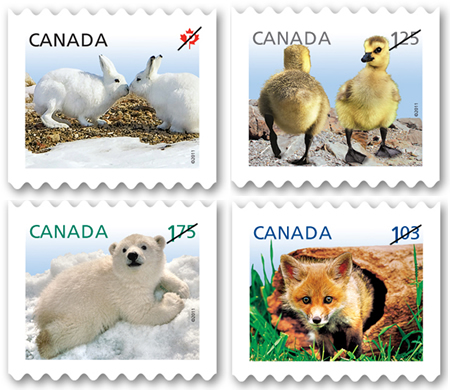Definitives: Baby Wildlife
January 17, 2011

Call it the “ahhh…” factor! In deciding to release a multiple-year series of definitives featuring Canada’s cutest, cuddliest baby creatures, it was a given that both collectors and consumers would have an emotional reaction to the images. From nose--rubbing Arctic hares and a steel-faced baby red fox, to fuzzy baby geese and a cheeky Polar bear cub who is definitely ready for his close-up, these stamps provide a rare glimpse into nature’s nursery.
Canadian definitives are “workhorse” stamps—they are the most accessible of our stamps and those mostly used for mailings. As such, they have to work the hardest to represent the whole of the country. In the past, they have featured a variety of imagery, including photos of Her Majesty Queen Elizabeth II, the Parliament buildings, various images of the flag, native trees and wildlife, and for the past several years, flowers, including a three-year series of Orchid stamps, interrupted in 2009, by our Vancouver 2010 Olympic definitives.
Since animals are always a popular choice for both definitives and commemoratives, it was certain that portraying the youngest, cutest members of our Canadian wildlife families was sure to tug on the heartstrings of mailers and provide collectors with another multiple-year series that could represent the whole of the country. According to Stamp Design Manager Danielle Trottier, “Canadians love their wildlife—and they love stamps that depict it. Deciding to focus the issue on animal babies was a natural—we knew there would be plenty of imagery to allow us to make great choices for the duration of the issue—and that every image had the potential to make viewers smile.”
The 2011 edition features the following four animal youngsters:
Arctic Hare leverets, (“P”-Domestic) as the babies are known, are born with their eyes wide open in late spring or early summer. Covered with grey-brown fur, when they lie still within their nests of moss or dry plants, they look like rocks, an illusion that protects them from harm.
The average Red Fox (US, $1.03) litter is four to eight kits (sometimes called cubs or pups), but it can number more than a dozen. Kits are born blind and can weigh as much as 115 grams. Their eyes are open by two weeks; by eight weeks they are fully weaned and by fall, they leave to claim their own territories.
Baby Canada Geese (Oversized mail, $1.25) or goslings, hatch roughly a month after the mother goose lays her eggs. Their coat of yellow to olive down soon turns dark grey, and feathers grow so they can fly. Goslings stay with their parents for a full year, returning with them after their first winter migration.
Born blind, usually in pairs, between November and February in snowy maternity dens dug by their mothers, Polar Bear cubs (International $1.75) are covered with light down fur, and weigh less than a kilo. Mom and babies remain in the den until as late as April, when they leave to prepare for the long walk to the ice floes.
Trottier continues, “It was the appeal of the photos that set the tone for the design. It’s why we surrounded the images with blue skies and just a touch of their habitat—the photos stand up so well on their own. It’s hard to look at any of these animals and not gush. They’re really that cute! Particularly, for young collectors, they’ll make a great introduction to the hobby.”
Designer Sophie Lafortune, owner of Klaxon Publicité agrees. She notes that she wanted to create a design that would most invite the kind of emotional response she knew this topic could arouse. “I wanted to design a series that would depict young animals in their natural habitat, and show them in a way that emphasized their charm, their curiosity, their naivety and the clumsy playfulness that is so much a part of them.”
Ultimately, this is why a photographic approach won out. Lafortune believes that it “more intimately captures the charm and vulnerability of these little ones.” She adds that keeping a subtle background ensures that animal babies will take centre stage on these stamps.
Other natural elements have been added to various items within the issue. For example, the designer sought out foot- and paw-prints of all four animals in this first year of the series, and used these prints to add dimension to the official first day cover.
The first in a three-year series of four definitives to be issued annually, the subsequent years’ stamps in this series will continue to showcase baby animals found in various regions throughout the country.

Coil of 100 stamps
$59.00
- Product #: 101351
- Denomination: 1 PERMANENT™ domestic rate
- Design: Monique Dufour, Sophie Lafortune
- Dimensions: 24 mm x 20 mm (horizontal)
- Printer: Lowe-Martin
- Printing Process: Lithography in 5 colours
- Quantity: Continuous printing
- Gum Type: Pressure sensitive
- Perforations: Simulated perforation
- Tagging: General, 4 sides
- Photography: Arctic Hares: Matthias Breiter | AlaskaStock.com; Canada Geese: Dreamstime.com, iStockphoto.com; Red Fox: Inmagine LLC; Polar Bear: Mark Newman | AlaskaStock.com
- Paper Type: Tullis Russell
- OFDC Cancellation Location: Rankin Inlet, Nunavut

Souvenir sheet of 4 stamps
$4.62
- Product #: 401351145
- Denomination: 1 x $4.62
- Dimensions: 120 mm x 72 mm (horizontal)
- Printing Process: Lithography in 8 colours
- Quantity: 205,000
- Gum Type: P.V.A.
- Perforations: 13+








